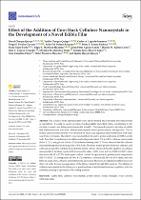Mostrar el registro sencillo del ítem
Effect of the Addition of Corn Husk Cellulose Nanocrystals in the Development of a Novel Edible Film
| dc.contributor.author | Choque Quispe, David | es_PE |
| dc.contributor.author | Choque Quispe, Yudith | es_PE |
| dc.contributor.author | Ligarda Samanez, Carlos A. | es_PE |
| dc.contributor.author | Peralta Guevara, Diego E. | es_PE |
| dc.contributor.author | Solano Reynoso, Aydeé M. | es_PE |
| dc.contributor.author | Ramos Pacheco, Betsy S. | es_PE |
| dc.contributor.author | Taipe Pardo, Fredy | es_PE |
| dc.contributor.author | Martínez Huamá, Edgar Luis | es_PE |
| dc.contributor.author | Aguirre Landa, John Peter | es_PE |
| dc.contributor.author | Agreda Cerna, Henrry W. | es_PE |
| dc.contributor.author | Loayza Cespedes, Julio César | es_PE |
| dc.contributor.author | Zamalloa Puma, Miluzca M. | es_PE |
| dc.contributor.author | Álvarez López, Genaro J. | es_PE |
| dc.contributor.author | Zamalloa Puma, Alan | es_PE |
| dc.contributor.author | Moscoso Moscoso, Elibet | es_PE |
| dc.contributor.author | Quispe Quispe, Yadira | es_PE |
| dc.date.accessioned | 2023-04-17T16:56:21Z | |
| dc.date.available | 2023-04-17T16:56:21Z | |
| dc.date.issued | 2022 | |
| dc.identifier.uri | https://hdl.handle.net/20.500.14168/767 | |
| dc.description.abstract | The cellulose from agroindustrial waste can be treated and converted into nanocrystals or nanofibers. It could be used to produce biodegradable and edible films, contributing to the circular economy and being environmentally friendly. This research aimed to develop an edible film elaborated with activated cellulose nanocrystals, native potato starch, and glycerin. The ac tivated cellulose nanocrystals were obtained by basic/acid digestion and esterification with citric acid from corn husks. The starch was extracted from the native potato cultivated at 3500 m of alti tude. Four film formulations were elaborated with potato starch (2.6 to 4.4%), cellulose nanocrystals (0.0 to 0.12%), and glycerin (3.0 to 4.2%), by thermoforming at 60 ◦C. It was observed that the cellulose nanocrystals reported an average size of 676.0 nm. The films mainly present hydroxyl, carbonyl, and carboxyl groups that stabilize the polymeric matrix. It was observed that the addition of cellulose nanocrystals in the films significantly increased (p-value < 0.05) water activity (0.409 to 0.447), white ness index (96.92 to 97.27), and organic carbon content. In opposition to gelatinization temperature (156.7 to 150.1 ◦C), transparency (6.69 to 6.17), resistance to traction (22.29 to 14.33 N/mm), and solu bility in acidic, basic, ethanol, and water media decreased. However, no significant differences were observed in the thermal decomposition of the films evaluated through TGA analysis. The addition of cellulose nanocrystals in the films gives it good mechanical and thermal resistance qualities, with low solubility, making it a potential food-coating material. | es_PE |
| dc.format | application/pdf | es_PE |
| dc.language.iso | eng | es_PE |
| dc.publisher | MDPI Journal List | es_PE |
| dc.rights | info:eu-repo/semantics/openAccess | es_PE |
| dc.rights.uri | es_PE | |
| dc.rights.uri | http://creativecommons.org/licenses/by-nc-nd/4.0/ | * |
| dc.subject | edible film; cellulose nanocrystals; potato starch; tensile strength; water activity; whiteness index | es_PE |
| dc.title | Effect of the Addition of Corn Husk Cellulose Nanocrystals in the Development of a Novel Edible Film | es_PE |
| dc.type | info:eu-repo/semantics/article | es_PE |
| dc.type.version | info:eu-repo/semantics/publishedVersion | es_PE |
| dc.publisher.country | CH | es_PE |
| dc.subject.ocde | http://purl.org/pe-repo/ocde/ford#2.11.01 | es_PE |
| dc.identifier.doi | https://doi.org/10.3390/nano12193421 | es_PE |


